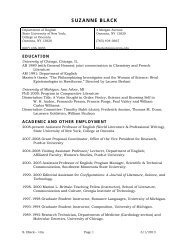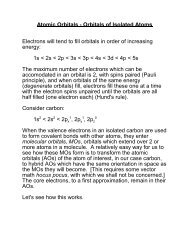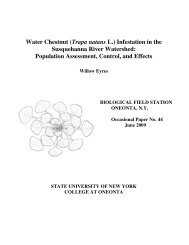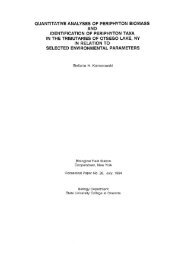Chapter 7 Electron Configurations and the Properties of Atoms 7.1 ...
Chapter 7 Electron Configurations and the Properties of Atoms 7.1 ...
Chapter 7 Electron Configurations and the Properties of Atoms 7.1 ...
Create successful ePaper yourself
Turn your PDF publications into a flip-book with our unique Google optimized e-Paper software.
<strong>Chapter</strong> 7 <strong>Electron</strong>ic <strong>Configurations</strong> <strong>and</strong> <strong>the</strong> <strong>Properties</strong> <strong>of</strong> <strong>Atoms</strong><br />
<strong>Electron</strong> affinity values generally are more negative in elements far<strong>the</strong>r to <strong>the</strong> right across a period.<br />
There are some notable exceptions, however, at <strong>the</strong> Group 2A <strong>and</strong> 5A elements.<br />
The Group 2A elements have electron affinities that are very close to zero because <strong>the</strong> added<br />
electron occupies <strong>the</strong> np orbital. Adding an electron to this higher-energy orbital requires energy, so<br />
<strong>the</strong> electron affinity is much lower (less negative) than predicted from general trends. The Group 5A<br />
elements have low (less negative) electron affinity values because <strong>the</strong> added electron occupies a halffilled<br />
np orbital <strong>and</strong> introduces new electron–electron repulsion forces.<br />
Notice that <strong>the</strong> Group 8A elements also have electron affinity values that are close to zero. An<br />
electron added to a noble gas element would occupy <strong>the</strong> (n + 1)s orbital in a higher-energy level.<br />
Thus, <strong>the</strong> noble gases generally do not form anions.<br />
7.5 Formation <strong>and</strong> <strong>Electron</strong> Configuration <strong>of</strong> Ions<br />
Section Outline<br />
7.5a Cations<br />
7.5b Anions<br />
7.5c Ion Size<br />
Section Summary Assignment<br />
As you saw in <strong>Chapter</strong> 2, ions form when atoms gain or lose electrons. Whe<strong>the</strong>r an atom gains or<br />
loses electrons is related to orbital energy <strong>and</strong> atomic electron configuration. Recall from Section 7.4<br />
<strong>and</strong> Interactive Figure 7.4.x that <strong>the</strong> energy <strong>of</strong> <strong>the</strong> highest-energy occupied orbitals increases in each<br />
element as you move down within a group <strong>and</strong> <strong>the</strong> energy <strong>of</strong> all atomic orbitals decreases in each<br />
element as you move left to right across <strong>the</strong> periodic table.<br />
Opening Exploration 7.5 <strong>Electron</strong> <strong>Configurations</strong> <strong>of</strong> Ions<br />
- 20 -
















